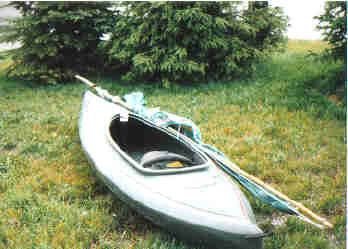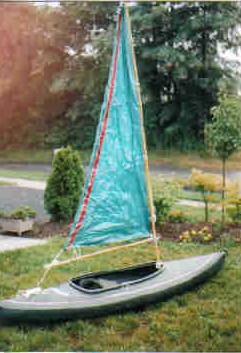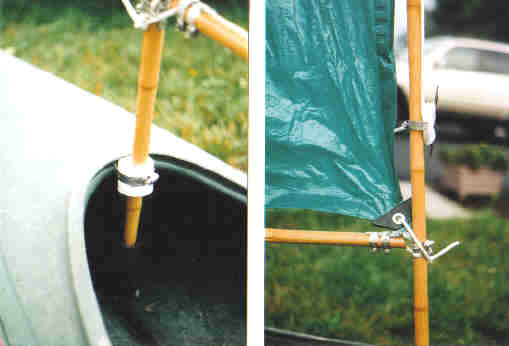
Rigging



Trip Diary
July 27, 2003
As the wind was blowing from the northwest, I first paddled across and slightly upstream to the West Shore. As the current was fast and the wind was in my face, this took quite some time but I finally reached the Marysville boat ramp (note to self, next time don't forget to take some water!). After rigging the sail, I headed out for its maiden voyage! Only a few hundred feet in this sail the wind started gusting. To say I started panicking is an overstatement, but it did produce some quick action to fold up the sail (I need to practice lowering it in a hurry). Even with the sail folded, enough area was exposed to cause some noisy sail flapping and kayak rocking. A flip would not be a diaster as I wear a life vest, can swim and the water is flat. But a big concern is other people trying to get involved and possibly getting hurt. A few weeks before, I watched a sudden squall capsize a daysailer on the Lake Clarke section of the Susquehanna. It took three fire department boats hours to tow the boat to shore ( it looked like they needed the practice however). Back in my voyage, while I was holding on to the flapping sail, the current carried the kayak well downstream. I finally pulled the sail and mast out of the sail step and stowed it to the kayak (this ability is important in designing a sail rig in my opinion). Another strenuous effort was required to paddle back to the boat ramp. While resting from this ordeal, a canoe float trip landed. My next trip would not lack a audience. This time the wind behaved for a while. I found that by sailing with the sail on the left and my paddle serving as a combination leeboard and rudder on the left, that the kayak tracked rather nicely perpendicular to the current, I was headed directly back to the boat ramp on the East Shore. After about three quarters of the way across I was rather well pleased with the sail. Then, the wind gusted again and a repeat of the hang on for dear life embarrassment started all over again. Either my skills, nerves, or sail design is not up to par with wind gusts! When the wind gusts subsided, I let the breeze push me downstream to sheltered water. I tied the sail to mast and paddled back up to the boat ramp. To me the day had been a great success, I was alive and the sail was intact.
August 10, 2003
August 18, 2003
August 24, 2003
August 31, 2003
Fall, 2003
A trip to Lake Alfred at Pequea PA on Columbus Day was also great. Again, a steady light breeze was key. At times the boat moved with excitement as I sailed back to harbor downwind.
2005
July 23,2005
Beaufort Wind Scale
Developed in 1805 by Sir Francis Beaufort of England
| Force | Wind (Knots) |
WMO Classification |
Appearance of Wind Effects | ||
|---|---|---|---|---|---|
| On the Water | On Land | ||||
| 0 | Less than 1 | Calm | Sea surface smooth and mirror-like | Calm, smoke rises vertically | |
| 1 | 1-3 | Light Air | Scaly ripples, no foam crests | Smoke drift indicates wind direction, still wind vanes | |
| 2 | 4-6 | Light Breeze | Small wavelets, crests glassy, no breaking | Wind felt on face, leaves rustle, vanes begin to move | |
| 3 | 7-10 | Gentle Breeze | Large wavelets, crests begin to break, scattered whitecaps | Leaves and small twigs constantly moving, light flags extended | |
| 4 | 11-16 | Moderate Breeze | Small waves 1-4 ft. becoming longer, numerous whitecaps | Dust, leaves, and loose paper lifted, small tree branches move | |
| 5 | 17-21 | Fresh Breeze | Moderate waves 4-8 ft taking longer form, many whitecaps, some spray | Small trees in leaf begin to sway | |
| 6 | 22-27 | Strong Breeze | Larger waves 8-13 ft, whitecaps common, more spray | Larger tree branches moving, whistling in wires | |
| 7 | 28-33 | Near Gale | Sea heaps up, waves 13-20 ft, white foam streaks off breakers | Whole trees moving, resistance felt walking against wind | |
| 8 | 34-40 | Gale | Moderately high (13-20 ft) waves of greater length, edges of crests begin to break into spindrift, foam blown in streaks | Whole trees in motion, resistance felt walking against wind | |
| 9 | 41-47 | Strong Gale | High waves (20 ft), sea begins to roll, dense streaks of foam, spray may reduce visibility | Slight structural damage occurs, slate blows off roofs | |
| 10 | 48-55 | Storm | Very high waves (20-30 ft) with overhanging crests, sea white with densely blown foam, heavy rolling, lowered visibility | Seldom experienced on land, trees broken or uprooted, "considerable structural damage" | |
| 11 | 56-63 | Violent Storm | Exceptionally high (30-45 ft) waves, foam patches cover sea, visibility more reduced | ||
| 12 | 64+ | Hurricane | Air filled with foam, waves over 45 ft, sea completely white with driving spray, visibility greatly reduced | ||